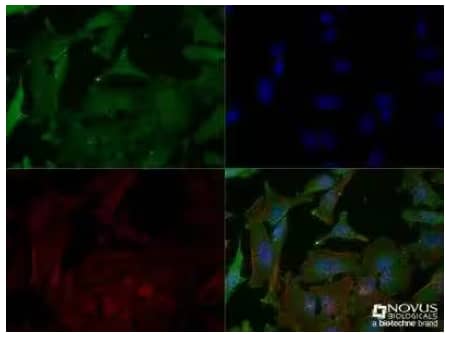p53, the protein product of the tp53 gene, is one of the most widely studied tumor suppressor proteins in cancer research. p53 is unique in that it demonstrates both tumor suppressive and tumor progressive properties depending on whether it is functional or mutated. The most common mutation in the p53 protein that leads to lack of tumor suppression activity is a missense mutation, however frameshift or nonsense mutations are also common. In fact, mutant p53 has exhibited dominant negative inhibition of the wild type version of the protein, demonstrating the fact that the p53 pathway has both positive and negative feedback loops. The p53 pathway is a large signal transduction pathway that affects DNA replication and division, apoptosis, cellular senescence and is composed of at least seven negative feedback loops and three positive feedback loops. Although p53's major influence is in cancer, the following articles describe how a p53 antibody was used to investigate its role in DNA damage and repair pathways.

p53 Antibody (PAb 240) [NB200-103] - HeLa cells were fixed for 10 minutes using 10% formalin and then permeabilized for 5 minutes using 1X TBS + 0.5% Triton-X100. The cells were incubated with anti-p53 (PAb 240) [NB200-103] at a 1:200 dilution overnight at 4C and detected with an anti-mouse Dylight 488 (Green) at a 1:500 dilution. Actin was detected with Phalloidin 568 (Red) at a 1:200 dilution. Nuclei were counterstained with DAPI (Blue). Cells were imaged using a 40X objective.
To begin, Lange et al used a p53 antibody to study the role for DNA polymerase ζ in maintaining genome stability and proliferative response. Overall, they sought out to determine how DNA polymerase ζ modulates skin carcinogenesis in mammals. First, mice were generated that lacked Rev3l, it's catalytic subunit, in all tissue that expressed Keratin 5, and it was found that while they survived, they did exhibit skin abnormalities and developed squamous skin carcinomas. Next, using a p53 antibody in immunohistochemistry on Rev3l-deleting skin samples, they saw that there was an increase in p53 due to DNA sensitivity to UV radiation. In addition, a p53 antibody revealed p53 mutant patches present in immunohistochemistry samples after exposure to UV radiation as well. After further testing, they concluded that base pair changes of p53 generated from UV radiation lead to tumor formation.
Next, Biswas et al used a p53 antibody to research the response of E2F1 to UV radiation via stimulation of DNA repair and suppression of carcinogenesis. After it was established that E2F1 protein stabilization can be a result of DNA double strand breaks, it was also found that E2F1 recruitment to these sites of DNA damage is impaired. Specifically, mice and cells lacking E2F1 had a lower efficiency in repairing UV damaged DNA. These mice were tested using a p53 antibody in immunohistochemistry and demonstrated a 2x increase in p53 positive keratinocytes after 5 weeks of UV treatment. Together these results suggest that a mutation in E2F1 leads to increased p53 mutations and subsequent skin tumor development in response to UV radiation.
-
Lange, S.S. () Dual role for mammalian DNA polymerase ζ in maintaining genome stability and proliferative responses PMID: 23386725.
-
Biswas, A.K. et al. () E2F1 responds to ultraviolet radiation by directly stimulating DNA repair and suppressing carcinogenesis PMID: 24741006.
-
Muller, P.A. et al. () Mutant p53 in cancer: new functions and therapeutic opportunities PMID: 24651012.